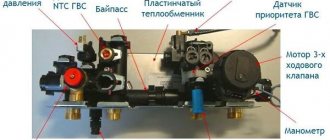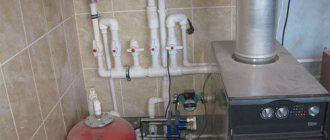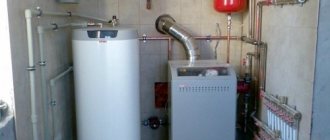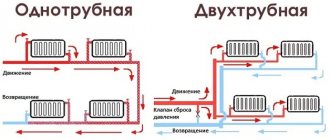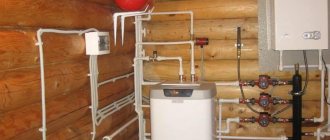Installation of a gas wall-mounted double-circuit boiler is not a final action that fully ensures the operation of the heating system and the supply of hot water.
The boiler is the most important element of the heating circuit; it provides hot water supply, but it is only a source of thermal energy.
To evenly distribute heating over the entire area of the house, a peripheral part of the system is required, which is installed based on operating conditions, room configuration and other considerations.
Mistakes made during its creation can negate all costs of purchasing a boiler and reduce heating efficiency to a minimum.
Let's take a closer look at this issue.
What is boiler piping
Boiler piping is a complex of pipelines and external components that is installed on gas boilers and heating appliances. In addition, piping is usually called the process of installing the periphery that forms the external part of the heating circuit.
Since the boiler is a double-circuit boiler, together with the heating it is necessary to assemble the DHW wiring and connect it to the water supply devices. Installation is a responsible and important job that requires the involvement of competent, qualified specialists.
It is also possible to independently piping the system if the user has copper soldering skills or knows how to handle polypropylene pipelines.
In any case, the result depends on the thoroughness and accuracy of the contractor, his level of training in the creation of thermal systems.
Types of gas flexible hoses
The current market offers a fairly extensive list of gas hoses. In addition to the material, you will also need to choose a manufacturer. And in this case it is better not to save. The item is bought once and for a long time. Having saved 500 rubles, you can then spend a lot on health and repairs if the pipe starts leaking gas. Therefore, let’s first look at the varieties.
Rubber-fabric
It has many advantages that allow it to be used in a gas system:
- easy installation;
- good flexibility;
- low cost;
- various sizes;
- excellent electrical insulation.
The disadvantage of such rubber parts is poor rigidity. Today, the industry produces hoses from a special material of high elasticity. Therefore, their service life can reach 10 years.
The cost of such hoses usually does not exceed $7.
Bellows metal
Professional gas fitters consider it the most suitable for gas systems. The service life of such hoses can be more than 25 years. It connects to a gas stove without any difficulty. Bellows systems can be connected to boilers and water heaters, and they are completely safe.
If you have a gas stove equipped with electric ignition in your kitchen, in order to connect the bellows device, a special insulating connection is created between it and the tap.
This type of hose bends freely and can withstand high pressure, reaching 6 atmospheres. It can withstand significant temperature changes ranging from -50 degrees to heating up to 200 degrees. The main disadvantage of a bellows hose is its cost. It is many times higher than similar gas connections.
The advantages of such bellows metal systems include:
- made of stainless steel;
- complies with GOST;
- meets all technical requirements;
- protected from any mechanical influences by a special polymer coating;
- able to withstand any mechanical impact;
- the warranty period exceeds 30 years;
- withstands voltage of 1500 Volts.
Oxygen
It can also be connected to gas stoves, but you need to take into account several very important points:
- The internal diameter must exceed 16 millimeters;
- The surface in contact with oxygen must be well cleaned of oil. Otherwise, the hose will overheat and material damage will occur.
The advantages of oxygen hoses include the following characteristics:
- withstands high pressure. It can reach 20 atmospheres;
- very simple installation;
- low cost;
- rich assortment;
- does not conduct electric current.
Advantages and disadvantages
The advantages include:
- It becomes possible to supply thermal energy to the premises through coolant circulation.
- The organization of hot water supply becomes possible.
- Some boiler models do not have built-in circulation pumps. The harness allows you to use external devices that completely solve the problem.
- Increasing the efficiency and economy of the boiler and the entire system as a whole.
The disadvantages of strapping can be considered:
- The need for careful design of the heating circuit.
- We have to perform a complex of complex and time-consuming work.
- For tying it is necessary to involve experienced specialists.
Despite the existence of some disadvantages, the operation of the system without strapping is impossible. Therefore, the main task becomes competent design and high-quality work of installers .
NOTE!
All attempts to minimize labor costs or financial costs in this case are dangerous - they can lead to destruction or unproductive operation of the system.
This is a must know valuable advice
Before purchasing a flexible hose, it is necessary to check the size of the thread at the outlet of the plate, its classification and whether it is straight or angular. If the outlet is of a direct type (directed into the wall), you must purchase a sleeve with a square at the end.
The gas hose should not be painted - this will accelerate its cracking. A more attractive look can be created by covering it with special paper or oilcloth.
It is also strictly forbidden to tightly seal gas communications with false plasterboard panels and other structures - this will make it difficult to carry out service work on individual elements.
To camouflage the gas supply system, a collapsible box is used, which can be easily dismantled if necessary. In this case, there will be constant access to all structural elements of the gas system.
It is forbidden to use unnecessary connections. Independent complication of a gas structure, according to technical regulations, may entail a fine or disconnection from gas supply
If a technician was called to connect the gas stove, it is necessary to check that the work was performed correctly: the excess tap from the tap at the lower end should be unscrewed, the flexible line should be directly connected exclusively to the tap located on the branch pipe, and its other end - only to the outlet of the gas stove.
It is also possible to use an adapter. Any additional installations are prohibited.
What elements does the diagram contain?
The wiring diagram is a complex made up of the following elements:
- Circulation pump.
- Valves for various purposes (safety, check, distribution, etc.).
- Expansion tank.
- Ball valves - drain, balancing, etc.
- Pressure gauge.
- Filters for purifying liquids from solid particles.
As a rule, most of these components are built into a wall-mounted double-circuit boiler, and there is no need to duplicate them in the external part of the system. Elements such as a circulation pump, expansion tank, all taps and valves are initially present in the boiler design as components.
A modern unit practically does not require the installation of external components, connecting directly to the system. The exception is non-volatile boilers that are not equipped with a circulation pump and other important elements.
An important element of the piping is air removal devices. A circulation pump can perform this function, but the efficiency of the process is low and takes a long time.
It is easier to install Mayevsky taps on radiators and place the supply pipeline in a vertical position (on non-volatile systems) . In addition, pressure and temperature monitoring devices, which provide information about the operation of the system, are of great importance.
Shut-off valves allow you to regulate or cut off the system lines in case of emergency situations.
Equipment with a closed system with forced circulation
When the heating system does not communicate with the surrounding air and operates under pressure, such circuits are only closed.
In this case, the following equipment is required to piping the boiler:
- a 100-200 watt pump, which should be installed for supply;
- membrane-type expansion tank to provide the coolant with additional volume during expansion;
- safety valve for releasing coolant if the permissible pressure is exceeded;
- an automatic air vent that will help the emerging air plug to leave the system on its own so that the coolant circulates freely throughout the circuit;
- pressure gauge - to control pressure.
These are required elements. The following options may also be included in the scheme:
- filter for gas unit;
- filter at the inlet of the heat exchanger to protect against debris;
- heat accumulator, which is advantageous to pair with solid fuel or electric boilers to save energy resources.
What materials are used
Materials for the manufacture of pipelines in heating systems are:
- Steel . In Soviet times, steel pipes were practically the only option. They are cheap and can withstand high pressure. The disadvantage is the need for welding work and the tendency to corrosion and the formation of limescale on the internal walls, which can completely block the cross-section of the pipeline. Later, stainless steel pipes appeared, which are not prone to lime deposits and corrosion.
- Copper . The most common material for creating piping for gas boilers. Connected by soldering, withstands high pressure. Not prone to corrosion or deposits on the inner walls of the tubes.
- Metal-plastic . Pipes appeared relatively recently. Their main value lies in the ease of installation - it does not require welding, all connections are made using wrenches. Metal-plastic pipes have plasticity, which in some cases makes it possible to do without fittings.
- Polypropylene . To install it, a special soldering iron is used, but it is inexpensive, like the pipelines themselves. Recently, this material has been actively used for assembling systems in private homes, since such pipes do not burst when frozen. The autonomous system assembled from polypropylene pipes will remain intact in the event of an accident, which is highly valued by users. The walls of the pipelines are quite thick, which some people think is a disadvantage.
- Low-density polyethylene (HDPE) . These pipes are also not burst by frozen water. However, HDPE pipes are not suitable for a heating system because they have a low operating temperature. They can only be used for the external part of underfloor heating systems.
The choice of the most suitable material is determined by the capabilities and preferences of the home owner.
It is recommended to make the system with a certain margin of safety, since redoing it in a finished and comfortable house is extremely expensive and difficult.
Recommendations for installing the battery yourself
- Before starting work, you need to shut off the flow of coolant in the heating system at the inlet and outlet or make sure that there is no liquid in the pipeline.
- Even before installation, you need to check that the radiator is complete. It must be assembled. If this is not the case, take a radiator key and assemble the battery according to the manufacturer's instructions.
The structure must be absolutely sealed, so abrasive materials cannot be used during assembly, as they destroy the material of the device. When tightening fasteners, do not forget that bimetallic devices use both left-handed and right-handed threads. When connecting sanitary fittings, it is extremely important to choose the right material. Typically, flax is used together with a heat-resistant sealant, FUM tape (fluoroplastic sealing material) or Tangit threads. Before starting installation work, you need to carefully plan the connection diagram. Batteries can be connected in a diagonal, side or bottom pattern
It is rational to install a bypass in a single-pipe system, that is, a pipe that will allow the system to function normally when the batteries are connected in series. After installation is complete, the system is turned on. This must be done by smoothly opening all the valves that previously blocked the path of the coolant. Opening the taps too sharply leads to clogging of the internal pipe section or hydrodynamic shocks. After opening the valves, it is necessary to bleed off excess air through an air vent (for example, a Mayevsky valve).
Batteries can be connected diagonally, sideways or downwards. It is rational to install a bypass in a single-pipe system, that is, a pipe that will allow the system to function normally when the batteries are connected in series. After installation is complete, the system is turned on. This must be done by smoothly opening all the valves that previously blocked the path of the coolant. Opening the taps too sharply leads to clogging of the internal pipe section or hydrodynamic shocks. After opening the valves, it is necessary to bleed off excess air through an air vent (for example, a Mayevsky valve).
Note! Do not cover batteries with screens or place them in wall niches. This will sharply reduce the heat transfer of the equipment. Correctly installed bimetallic heating radiators are the key to their long and trouble-free operation
If you have any doubts about your ability to install them yourself, it is better to contact a specialist
Correctly installed bimetallic heating radiators are the key to their long and trouble-free operation. If you have any doubts about your ability to install them yourself, it is better to contact a specialist.
Piping diagrams for a double-circuit wall-mounted boiler
There are several strapping schemes used depending on the type and specific features of the system:
- Gravity circuit, which is used in systems with natural coolant circulation. Pipelines and radiators are installed with a slope that ensures that hot layers of liquid move up and cooler layers move down.
- Circuit with a circulation pump. The coolant movement is forced, the system operation is more stable and efficient. This option is used most often.
- Collector circuit. It appeared relatively recently; its difference from the generally accepted options is the connection of the boiler to the manifold, from which all lines of the system are powered. Suitable for complex systems consisting of a radiator line and a heated floor.
- Emergency scheme. It is designed for use in the event of a sudden power outage. Usually the boilers stop working, but if there is an emergency piping circuit, you can use heating using natural coolant circulation.
IMPORTANT!
Both collector and emergency circuits are more expensive and require more labor during assembly. At the same time, they allow for more efficient heating and the ability to heat the house during a power outage.
Best Pipes for the Job
The use of polypropylene pipes is quite common; if they are welded correctly, the pipeline will be monolithic. But when the coolant temperature increases from 80 degrees, such pipes become fragile and vulnerable to mechanical damage. Such components are only suitable for systems with low temperature indicators; the basis should be an automated unit.
Metal-plastic specimens, in contrast to polypropylene pipes connected to the heating boiler, withstand high temperatures much more effectively, the indicator reaches 95 degrees. For most systems, such figures are enough, but it would not be superfluous to install protection against excessive heating of the coolant.
The only drawback will be the narrowing at the junction of the fittings, whose design does not allow maintaining primary permeability after assembly. Connections must be constantly checked; there have been cases when the bypass and joints leaked over time. This design option is most suitable for heating in which water is the coolant.
What does the scheme depend on?
The choice of piping scheme depends on the configuration of the heating system, its type and composition.
The main influencing factors are:
- Type of system - open or closed.
- Is there an additional water heater (boiler).
- Are there additional circuits or a heated floor system?
Depending on the combination of certain elements, different connection methods can be used:
- Direct connection. Used on conventional systems that do not have any add-ons.
- With hydraulic separator. This option is necessary if there are several circuits with different temperatures - the underfloor heating system cannot be higher than 30°, and the radiator circuit requires a much higher temperature.
- With additional heat exchanger. This is a method when the coolant from the boiler circulates in a small circle, and there is another heat exchanger outside, where thermal energy is transferred to another. liquid directly circulating in the system. This option is rare and is used where different types of coolant are needed (with different freezing temperatures).
The choice of the desired option depends on the configuration and composition of the system. Most often, a direct connection is used, which is simple and reliable .
Doesn't depend on what
The piping scheme does not depend on the type of boiler and the type of fuel used. For all types and designs of boilers, the same piping methods are used , regardless of the installation method (floor or wall), the type of fuel (gas, pellets, electricity or diesel fuel), etc.
For complex systems, minor amendments are sometimes made at the design stage, but they do not play a decisive role and do not change the general principle.
The only difference that is possible is the piping for single- and double-circuit boilers, when either there is or is not a hot water supply line.
Types of gas taps
In old buildings, two types of cranes were usually installed on vacation:
- petal;
- suberic.
The differences between the designs of these products can be seen in the figure.
When the slab is replaced or the valve fails, it is best to install a new ball valve.
This device is much better, but more expensive. Installation of an Italian faucet will cost $10. You can also install a cheaper domestic faucet, costing $5. They are no worse than their foreign counterparts, but sometimes have defects. Therefore, do not forget to take a receipt with you when purchasing so that you can exchange the defective product for a good one.
The most popular scheme
Let's look at the procedure for creating the most popular type of binding - straight. The most common are energy-dependent boilers, so a piping scheme with an existing circulation pump will be described.
Necessary actions:
Installation of all devices
All radiators, washbasins, bathtubs or showers, and kitchen sinks are being installed. It is necessary that by the time the elements of the heating circuit or DHW are connected, all elements are installed and ready for connection.
The readiness of the heating line is especially important, since the hot water supply circuit works for delivery and can be expanded during operation.
Connecting heating system pipelines
All radiators are connected in series with each other by pipelines. One end is connected to the flush line (supply) of the boiler, the other to the return line .
It is important to ensure the tightness and integrity of the system. To avoid errors, you should constantly check the wiring diagram created during the design of the system.
DHW connection
A pipeline is installed, connected to the DHW pipe of the gas boiler. Taps for mixers are connected to the gap through tees . It is recommended that each mixer be equipped with its own ball valves to shut off the water supply when necessary.
The last step will be to connect the boiler to the power line - cold water supply . After this, you can make a test run and check the quality of work and integrity of all pipelines.
All detected errors are immediately eliminated, for which the system is stopped, the water is drained and the circuit is readjusted.
Equipment with open gravity system
With an open gravity system, the entire load falls on the open expansion tank.
It performs the following functions:
- takes away excess amount of coolant;
- compensates for increased pressure;
- removes air and hot steam when the coolant boils.
The volume of the tank should not be less than 10 percent of the coolant volume. More is possible. Install it at the top point of the circuit, where the accelerating manifold ends. From the tank, the filling goes back to the heat exchanger, with a slope that ensures that air pockets are removed and the coolant moves by gravity.
Cold water is usually poured through an open expansion tank to compensate for evaporation.
Connecting a gas cylinder to a stove how to connect a gas cylinder to a stove
Not everyone will afford to build a country mansion with all the amenities. Some of the population are content with small plots with wooden houses, where they come on weekends. There is no point in running a gas pipe to the house, and it is expensive, but connecting a gas cylinder to the stove will come in handy. And it’s inexpensive, and you can do it yourself.
Do you know what needs to be done to properly connect the cylinder to the stove? If not, then after reading this article to the end, it will not be difficult for you to make the connection yourself.
What you need to connect
- Gas stove. She must not be quite old. Be sure to check the integrity of connections and burners.
- Gas reducer (30 mbar). Experts consider gearboxes with threaded connections and brass nuts to be the most reliable.
- Gas hose. It should be 1.5 meters longer. For example, if there are 5 meters from the installation site of the slab to the cylinder, then you will need 6.5 m; this is necessary so that the hose is not connected under tension, so it can crack faster.
- Fittings and clamps for connections. This will be needed if you decide to use an old stove; new models already come with such adapters.
- The tool must be copper-plated or brass-plated. Safety rules provide for working with gas connections only with such keys; they do not give a spark in case of accidental failure.
- As an additional sealing material, you will need flax or fum tape.
- Soap solution.
A special gas hose must be used for connection. When purchasing in a store, explain this to the seller. Under no circumstances should you use an old hose that was lying in your basement; even if it looks good, it may have internal cracks and the consequences will be disastrous.
Work order
We will assume that the stove in the kitchen is already installed. The gas cylinder must be placed in another room or at least 5 meters away from the stove. The place for the cylinder must be clean and prepared. Build a special mount from wooden slats.
Connection to plate
First you need to connect the hose to the stove. This is a completely safe job. We screw it onto the hose of the stove, tighten it with a clamp and, screwing the fum tape onto the inlet fitting of the stove, wrap it until it stops.
Connection to cylinder
First you need to install a reducer on the cylinder. It is screwed onto a special adapter with the accompanying wrapping of fum tape.
The entire connection process must take place with a thorough inspection of each part:
- There should be no contamination on the gearbox and the cylinder, especially at the threaded connections.
- The hose deserves special attention. In addition to the appropriate length, it should not have cracks or narrowing, and do not allow it to twist. It is also better to replace it after the expiration date.
- There should be no rust on the clamps during operation; this can lead to their rupture. If corrosion appears, it is better to immediately replace them or purchase specialized ones with anti-corrosion treatment.
How to choose the right gas hose
It is necessary to purchase such devices only in special stores that have certificates for each product.
The gas hose braid should have a yellow mark. It is placed only on the gas hose; on the water hose, a blue-red line is placed.
All hoses come in different sizes to accommodate a wide range of connections. The most common range is one to two meters. Usually, fastening threads are made with dimensions of 1/2″–3/4″.
The ends can be equipped with two nuts. The so-called nut-nut, sometimes a nut with a fitting. This hose is called a “nut-fitting”. A nut with an internal thread is called a female; a fitting with an external thread is called a male.
